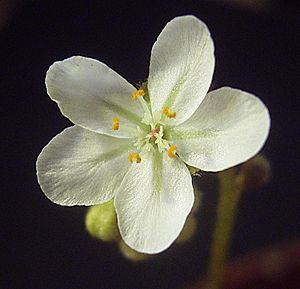Drosera kenneallyi facts for kids
Quick facts for kids Drosera kenneallyi |
|
|---|---|
 |
|
| Scientific classification | |
| Genus: |
Drosera
|
| Species: |
kenneallyi
|
Drosera kenneallyi is a special type of carnivorous plant from the Drosera family. It's found only in the Kimberley region of northern Western Australia. This plant is unique because it catches insects to get its food!
About Drosera kenneallyi
Drosera kenneallyi is a fascinating plant that grows its leaves in a tight circle, like a flower close to the ground. Thin stalks, called petioles, grow from the middle of this circle. These stalks are usually about 1.5 to 2.2 millimeters wide.
At the end of these stalks are small, red leaves that are 2 to 3 millimeters wide. These are the plant's insect-catching leaves! From November to December, Drosera kenneallyi grows flower stalks that are about 12.5 to 20.5 centimeters tall. These stalks have 10 to 20 white flowers.
Where it Lives
You can find Drosera kenneallyi growing in sandy soil near the Airfield Swamp. The first plant samples were collected close to a Eucalyptus latifolia tree in this area.
This plant has a clever way to survive. In January and February, its home often floods with warm water. Drosera kenneallyi can change the position of its leaf stalks. This helps its insect-catching leaves stay above the water, so it can still catch food!
How it Was Discovered
Drosera kenneallyi is native to the Mitchell Plateau in the Kimberley region of northern Western Australia. It's quite common within about 5 kilometers of the Mitchell Plateau Airfield.
The plant was first collected in 1982 by Kevin F. Kenneally. The species was named after him! Later, in 1993, a scientist named Allen Lowrie traveled to the Kimberley. He collected this plant and started growing it. This helped scientists confirm that D. kenneallyi was a new and different species.
Lowrie officially described this plant in 1996 in a science journal called Nuytsia. He noted that D. kenneallyi is very similar to another plant called D. falconeri, which lives in similar places. However, Drosera kenneallyi has smaller leaves and shorter flower stalks, which helps tell the two species apart.
See also
 In Spanish: Drosera kenneallyi para niños
In Spanish: Drosera kenneallyi para niños


